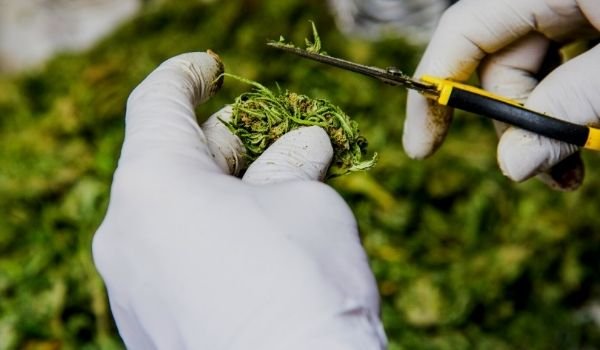Trimming cannabis is a critical step in the process regardless of which method you choose. Learn about dry vs. wet trimming here!
Dry trimming has become almost unilaterally preferred by cultivators due to the perceived superiority of the results and ease of handling the flower, but drying takes time. On the other end of the spectrum, trimming wet flowers can be done right after harvest, but it often gunks up trimming shears within seconds. If all worked out as planned, maybe most farms would only engage in dry trimming. Yet, time crunches happen. Thus, many farms have to expend considerable capital investments for labor costs to have people process wet material.
To be clear, dry trimming is performed after the cannabis has been harvested and allowed to dry for weeks in a controlled environment; wet trimming is any trimming done before this stage. In either method, the process of trimming is a critical step during the cannabis harvest.
Luckily, there’s hope through automated trimming equipment. Cannabis Tech reached out to an industry expert to get the skinny on which methods are the best.

DOES WET OR DRY TRIMMING PROVIDE BETTER RESULTS?
In an interview with Cannabis Tech, Co-Founder of Triminator, Dana Mosman chimed in on trim methods saying, “a dry trim, generally, I think produces a better nose to the product. Better smell, better color. So there’s something about the drying process that allows it to lock in those properties, and there’s no oxidation basically, so when it goes to the wet trim, and it’s sheared off in that product in that it’s trimmed as that part of the process you end up with a bit of enzymatic browning – you lose a little bit of that smell and color.”
“So, for like the flower perspective and the smell color, all the shelf qualities, I think it’s been pretty well established that dry trimming produces those properties better than wet trimming. So for a boutique, top-shelf flower, I would certainly choose dry trimming. But, to get to dry trimming, you have to hang dry the plant, which takes up a lot of space, right? Processors touch the plant multiple times – when they take it down in the field, then hang it up, then cut it down. I wouldn’t recommend hand-bucking unless you’re going for top-shelf flowers,” Mosman explained about the labor-intense process.
Outside of boutique flower, Mosman detailed the differences from a producer’s perspective. “Dry trimming is simply less process efficient. That’s where wet trimming wins. You go into the field; you take it down, run it through the trimmer, and then hang it on the drying racks, and you’re done.”
INDUSTRIALIZATION MEANS THE FORWARD MARCH OF AUTOMATION
Delicate and in-depth handling of each bud is the best way to preserve the terpenes, cannabinoids, and other valuable compounds within the plant. For top-shelf cannabis, this is ideal, but for all other production levels, the labor cost may be too steep.
Here’s where automated cannabis trimming equipment is crucial to the cannabis industry. According to Mosman, dry trimming units can process 6 pounds of cannabis per day, or 5 to 8 pounds per hour, all for the cost of a few thousand dollars.
According to Mosman, “We always look at it as a tool, like any part of what we’re doing, because we have a really automated process now. From bucking to trimming, you can almost be touchless in terms of human interface with it. There are obviously still operators; these are just tools in the grower’s quiver.”
In terms of cost savings and labor reduction, Mosman stated, “We see it as a way to reduce their overhead and still have the same quality product. So it’s never going to 100 percent replace hand trimmers, but if you can cut your labor costs by 80 to 95 percent and still have the same type of output product that you had with a hundred percent hand input.”
While craft enthusiasts might hate the sound of this, we’re clearing the second decade of cannabis markets in certain states, and cultivators must be more cost-conscious, especially independent growers, in order to maintain a highly competitive market.
NOT EVERYTHING’S A NAIL WHEN YOU HOLD A HAMMER
While automated trimming is a significant advancement, it is not without its set of risks, especially when the trimming units are far and away from your operation. An additional risk was brought to light in Michigan headlines recently with the recall of several products due to contamination that occurred during trimming.
According to the local government officials, “Several batches of marijuana were run through the mechanical trimmer of Michigan Medical Marijuana LLC, doing business as Glo, before retesting for microbial failures. The mechanical trimmer was contaminated with banned chemical residues Bifenthrin and Chlorfenapyr.”
As the story unfolds in Michigan it’s a glaring reminder, that as with all production equipment, stringent operating procedures and cleaning schedules must be maintained and enforced.
Additionally, for those meticulously focused on a boutique product, automated trimming still isn’t quite an ideal choice. Perhaps it will never become so, but as alcohol ranges from moonshine to Jack Daniels and international liquors over $100 a bottle, there will be room for every sort of cultivator in the future of cannabis. We might even see automated options that fit within top-shelf cultivators someday.

